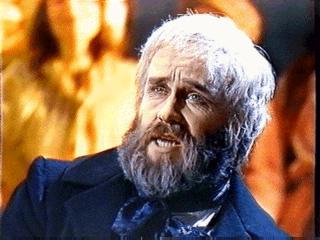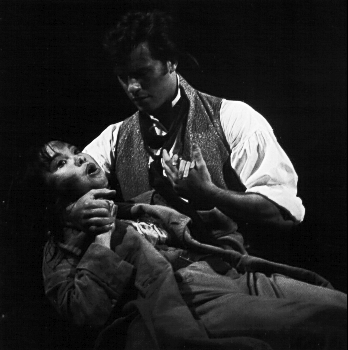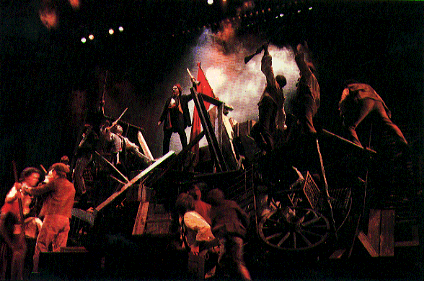
In 1815, in France, a man named Jean Valjean was released after nineteen years in prison. He had been sentenced to a term of five years because he stole a loaf of bread to feed his starving sister and her family, but the sentence was later increased because of his attempts to escape. During his imprisonment he astonished others by his exhibitions of unusual physical strength.
Freed at last, he started out on foot for a distant part of the country. Innkeepers refused him food and lodging because his yellow passport revealed that he was a former convict. Finally he came to the house of the Bishop of D-, a saintly man who treated him graciously, fed him, and gave him a bed. During the night Jean stole the bishop's silverware and fled. He was immediately captured by the police, who returned him and the stolen goods to the bishop. Without any censure, the priest not only gave him what he had stolen but also added his silver candlesticks to the gift. The astonished gendarmes released the prisoner. Alone with the bishop, Jean was confounded by the churchman's attitude, for the bishop asked only that he use the silver as a means of living an honest life.
In 1817, a beautiful girl named
Fantine lived in Paris. She
gave birth to an illegitimate child,
Cosette, whom she left with
Monsieur and Madame
Thenardier to rear with their own children.  As time went on,
the Thenardiers demanded more and more money for Cosette's support
yet treated the child cruelly and deprived her even of necessities.
Meanwhile, Fantine had gone to the town of M--and obtained a job in a
glass factory operated by Father
Madeleine, a kind and generous man whose history was known to no
one, but whose good deeds and generosity to the poor were public
information. He had arrived in M--a poor laborer, and by a lucky
invention he was able to start a business of his own. Soon he built a
factory and employed many workers. After five years in the city, he
was named mayor and was beloved by all the citizens. He was reported
to have prodigious strength.
As time went on,
the Thenardiers demanded more and more money for Cosette's support
yet treated the child cruelly and deprived her even of necessities.
Meanwhile, Fantine had gone to the town of M--and obtained a job in a
glass factory operated by Father
Madeleine, a kind and generous man whose history was known to no
one, but whose good deeds and generosity to the poor were public
information. He had arrived in M--a poor laborer, and by a lucky
invention he was able to start a business of his own. Soon he built a
factory and employed many workers. After five years in the city, he
was named mayor and was beloved by all the citizens. He was reported
to have prodigious strength.  Only one man,
Javert, a police inspector,
seemed to watch him with an air of suspicion. Javert was born in
prison. His whole life was influenced by that fact, and his fanatical
attitude toward duty made him a man to be feared. He was determined
to discover the facts of Father Madeleine's previous life. One day he
found a clue while watching Father Madeleine lift a heavy cart to
save Father Fauchelevant
who had fallen under it. Javert realized that he had known only one
man of such prodigious strength, a former convict named Valjean.
Only one man,
Javert, a police inspector,
seemed to watch him with an air of suspicion. Javert was born in
prison. His whole life was influenced by that fact, and his fanatical
attitude toward duty made him a man to be feared. He was determined
to discover the facts of Father Madeleine's previous life. One day he
found a clue while watching Father Madeleine lift a heavy cart to
save Father Fauchelevant
who had fallen under it. Javert realized that he had known only one
man of such prodigious strength, a former convict named Valjean.
 Fantine had
told no one of Cosette, but knowledge of her illegitimate child
spread and caused Fantine to be discharged from the factory without
the knowledge of Father Madeleine. Finally Fantine became a
prostitute in an effort to pay the increasing demands of the
Thenardiers for Cosette's support. One night Javert arrested her
while she was walking the streets. When Father Madeleine heard the
details of her plight and learned that she was sick, he sent Fantine
to a hospital and promised to bring Cosette to her. Just before the
mayor left to get Cosette, Javert confessed that he had mistakenly
reported to the Paris police that he suspected Father Madeleine of
being the former convict, Jean Valjean. He said that the real Jean
Valjean had been arrested under an assumed name. The arrested man,
Champmathieu, was to be tried two
days later.
Fantine had
told no one of Cosette, but knowledge of her illegitimate child
spread and caused Fantine to be discharged from the factory without
the knowledge of Father Madeleine. Finally Fantine became a
prostitute in an effort to pay the increasing demands of the
Thenardiers for Cosette's support. One night Javert arrested her
while she was walking the streets. When Father Madeleine heard the
details of her plight and learned that she was sick, he sent Fantine
to a hospital and promised to bring Cosette to her. Just before the
mayor left to get Cosette, Javert confessed that he had mistakenly
reported to the Paris police that he suspected Father Madeleine of
being the former convict, Jean Valjean. He said that the real Jean
Valjean had been arrested under an assumed name. The arrested man,
Champmathieu, was to be tried two
days later.
 That night Father Madeleine struggled with his own
conscience, for he was the real Jean Valjean. Unwilling to let an
innocent man suffer, he went to the court for the trial and
identified himself as Jean Valjean. After telling the authorities
where he could be found, he went to Fantine. Javert came there to
arrest him. Fantine was so terrified that she died.
That night Father Madeleine struggled with his own
conscience, for he was the real Jean Valjean. Unwilling to let an
innocent man suffer, he went to the court for the trial and
identified himself as Jean Valjean. After telling the authorities
where he could be found, he went to Fantine. Javert came there to
arrest him. Fantine was so terrified that she died.
Valjean was able to escape from Javert. Shortly afterward he was able to take Cosette, a girl of eight, away from the Thenardiers. He grew to love the child greatly, and they lived together happily in the Gorbeau house on the outskirts of Paris. When Javert once more tracked them down, Valjean escaped with the child into a convent garden, where they were rescued by Fauchelevant, whose life Valjean had saved when the old peasant fell beneath the cart. Fauchelevant was now the convent gardener. Valjean became his helper, and Cosette was put into the convent school.
Years passed. Valjean left the convent and took Cosette, her schooling finished, to live in a modest house on a side street in Paris. The old man and the young girl were little noticed by their neighbors. Meanwhile Thenardier had brought his family to live in the Gorbeau house and he now called himself Jondrette. In the next room lived Marius Pontmercy, a young lawyer estranged from his grandfather because of his political views. Marius was the son of an officer whose life Thenardier had saved at the battle of Waterloo. The father, now dead, had asked his son to repay Thenardier for his deed. Marius never suspected that Jondrette was really his father's benefactor. When the Jondrettes were being evicted from their quarters, however, he paid their rent from his meager resources.
During one of his evening walks, Marius met Cosette and Valjean. He fell in love with the girl as he continued to see her in the company of her white-haired companion. At last he followed her to her home. Valjean, noticing Marius, took Cosette to live in another house.
One morning Marius received an urgent letter delivered by Eponine Jondrette. His neighbors were again asking for help, and he began to wonder about them. Peeping through a hole in the wall, he heard Jondrette speak of a benefactor who would soon arrive. When the man came, Marius recognized him as Cosette's companion. He later learned Cosette's address from Eponine, but before he saw Cosette again he overheard the Jondrettes plotting against the man whom he believed to be Cosette's father. Alarmed, he told the details of the plot to Inspector Javert.
Marius was at the wall watching when Valjean came to give Jondrette money. While they talked, numerous heavily armed men appeared in the room. Jondrette then revealed himself as Thenardier. Horrified, Marius did not know whom to protect, the man his father had requested him to befriend or the father of Cosette. Threatened by Thenardier, Valjean agreed to send to his daughter for more money, but he gave a false address. When this ruse was discovered, the robbers threatened to kill Valjean. Marius threw a note of warning through the hole in the wall as Javert appeared and arrested all but Valjean, who made his escape through a window.
 Marius finally located Cosette. One night she
told him that she and her father were leaving for England. He tried,
unsuccessfully, to get his grandfather's permission to marry Cosette.
In despair, he returned to Cosette and found the house where she had
lived empty. Eponine met him there and told him that his
revolutionary friends had begun
a revolt and were waiting for him at the barricades. Because Cosette
had disappeared, he gladly followed Eponine to the barricades, where
Javert had been identified as a spy by
Little Gavroche and bound.
During the fighting Eponine gave her life to save Marius. As she
died, she gave him a note which Cosette had given her to deliver. In
the note, Cosette told him where she could be found.
Marius finally located Cosette. One night she
told him that she and her father were leaving for England. He tried,
unsuccessfully, to get his grandfather's permission to marry Cosette.
In despair, he returned to Cosette and found the house where she had
lived empty. Eponine met him there and told him that his
revolutionary friends had begun
a revolt and were waiting for him at the barricades. Because Cosette
had disappeared, he gladly followed Eponine to the barricades, where
Javert had been identified as a spy by
Little Gavroche and bound.
During the fighting Eponine gave her life to save Marius. As she
died, she gave him a note which Cosette had given her to deliver. In
the note, Cosette told him where she could be found.
In answer to her note, Marius wrote that his grandfather would not permit his marriage, that he had no money, and that he would be killed at the barricade. Valjean discovered the notes and set out for the barricades. Finding Javert tied up by the revolutionists, he was given the chance to kill him. Valjean instead freed the inspector. The barricade fell to the army. In the confusion Valjean came upon the wounded Marius and carried him into the Paris sewers.
After hours of wandering, he reached a locked outlet. There Thenardier, unrecognized in the dark, met him and agreed to open the grating in exchange for money. Outside Valjean met Javert, who took him into custody. Valjean asked only that he be allowed to take Marius to his grandfather's house. Javert agreed to wait at the door, but suddenly he turned and ran toward the river. Tormented by his conscientious regard for duty and his reluctance to return to prison the man who had saved his life, he jumped into the river.

 When Marius recovered, he and Cosette were married.
Valjean gave Cosette a generous present, and for the first time
Cosette learned that Valjean was not her real father. Valjean told
Marius only that he was an escaped convict, believed dead, and he
begged to be allowed to see Cosette occasionally. Gradually Marius
banished him from the house. Then Marius learned from Thenardier that
it was Valjean who had rescued Marius at the barricade. Marius and
Cosette hurried to Valjean's lodgings, to find him on his deathbed.
He died knowing that his children loved him and that all his
entangling past was now clear. He gave the bishop's silver
candlesticks to Cosette, with his last breath saying that he had
spent his life in trying to be worthy of the faith of the Bishop of
D-. He was buried in a grave with no name on the stone.
When Marius recovered, he and Cosette were married.
Valjean gave Cosette a generous present, and for the first time
Cosette learned that Valjean was not her real father. Valjean told
Marius only that he was an escaped convict, believed dead, and he
begged to be allowed to see Cosette occasionally. Gradually Marius
banished him from the house. Then Marius learned from Thenardier that
it was Valjean who had rescued Marius at the barricade. Marius and
Cosette hurried to Valjean's lodgings, to find him on his deathbed.
He died knowing that his children loved him and that all his
entangling past was now clear. He gave the bishop's silver
candlesticks to Cosette, with his last breath saying that he had
spent his life in trying to be worthy of the faith of the Bishop of
D-. He was buried in a grave with no name on the stone.